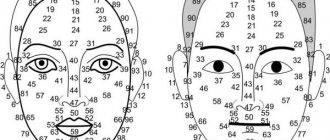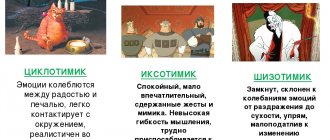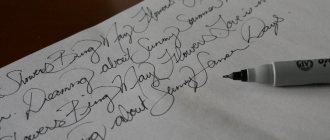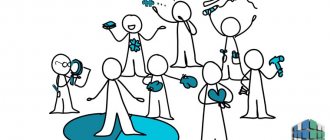A person’s personal qualities determine his character. The set of traits can be very different, as well as the predetermining factors of actions. However, knowing the typological picture of character, one can predict a person’s behavior and his reaction to various stimuli.
Not only his mental properties, but also his appearance, period of birth, handwriting and even appearance will help determine a person’s character. Of course, despite a certain typology, the characteristics of an individual may differ. Despite this, knowledge of character types will help you find the right approach to a person, predict his reaction, behavior and communication in a given situation. In our article today you will find useful information about human characters and how to correctly determine them.
The meaning of a person's character
Character is a stable structure of mental properties that predetermine a person’s behavior, life goals, his reaction to stimuli and communication.
The importance of character is difficult to overestimate. It is he who is decisive in the construction of human destiny, choice and freedom.
In psychology, a person’s character is considered an individual combination of certain personality traits. A set of qualities determines the attitude of an individual to the entire environment, which is manifested in the actions and behavior of a person.
Character means a lot in a person's life. Knowledge of the typological picture of characters is necessary not only to build communication with the chosen person, but also to predict his goals and possible reaction. This is important, for example, when hiring, when the candidate is assessed from all sides.
Character and temperament
A person’s character and temperament have a close relationship with each other. Character is a complex of individual characteristics and qualities of a person that determine his own actions in relation to other people. Temperament is a set of properties of mental activity that have a significant impact on behavioral reactions. Temperament manifests itself under the influence of the nervous system, and character develops against the background of the human psyche and is formed throughout life under the influence of the environment.
Temperament is the strength of the manifestation of emotions, actions, deeds, impressionability and various individual characteristics of the psyche. Temperament is an innate feature of a person, accompanied by the course of behavioral and mental processes that shape him as a personality in the social environment. Temperament is characterized by intensity, duration of mental processes, and external behavioral reactions.
Human character types
Human character has been studied from all sides for a long time. Long-term study, which was passed down from generation to generation among scientists, made it possible to derive typological pictures. Of course, different scientific schools provide a different list of human characters. There are a huge number of classifications, or, more precisely, attempts to classify all knowledge about human character into a single system. Unfortunately, none of them can be called deep and effective. Since a person’s individuality is not laid down at birth, but is acquired with age through the accumulation of experience, life situations, serious decisions, etc. However, it is customary to rely on several typologies. They are considered the most true, holistic and cover a large number of characteristics. We have described them below.
Types of human character: character types by body type
The famous German psychologist E. Kretschmer formulated his vision of human character types, based on the external data of the individual, namely, physique.
- Picnic type (cyclothymics) . Translated from Greek, “picnic” means a fat, plump person. According to the teachings of Kretschmer, picnics are people prone to obesity, of average height with a large head, short neck and a wide face with small features. This type is characterized by the following character qualities:
- emotionality;
- adaptability;
- sociability;
- contact;
- cheerful disposition, etc.
As a rule, with mental disorders, picnics are susceptible to manic-depressive psychosis.
- Athletic type (ixothymic). The athletic type is characteristic of athletes, in particular, wrestlers. These are tall people with developed strong muscles, broad shoulders, a strong skeleton and a powerful chest. Character traits are determined by the following traits:
- imperiousness;
- calm disposition;
- restraint;
- practicality;
- unimpressiveness;
- poor adaptability, etc.
As a rule, athletes do not like change. Mental disorders in people of this type are often accompanied by epileptic seizures.
- Asthenic type (schizothymic). People of the asthenic type are thin, have poorly developed muscles, long limbs, a flat chest and an elongated face. Asthenics are characterized by the following qualities:
- stubbornness;
- seriousness;
- isolation;
- poor adaptability to new life circumstances;
- gloominess, etc.
With mental disorders, asthenics are prone to schizophrenia.
Of course, Kretschmer’s classification of human characters is quite “rigid”. Therefore, it cannot be said that a person of one or another physique will necessarily have the listed character traits. In addition to external data, you also need to rely on other indicators. The positive or negative character of a person does not depend solely on his external structure.
Human character groups: Jung's classification
Perhaps the most famous classification of human character types belongs to the Swiss psychiatrist C. Jung. The scientist developed his typological picture based on the dominant mental functions of the individual. Its classification is based on a person’s belonging to the internal or external world. Character groups include only two classifications: introverted and extroverted types.
- Introvert. The introverted type is characterized by isolation, “withdrawal into oneself.” at the same time, the person is fenced off from the outside world, carefully analyzes his actions, behavior and events, often suspecting everyone of contradictory actions. Introverts have few friends because it is difficult for them to open up and connect with others. Such people are often lonely, but this does not bother them. Introverts love persistence and do not handle change well. These are very suspicious people with a high degree of anxiety. Introverts love to delve into themselves, listen to their own feelings and monitor their health.
- Extrovert. People of the extroverted type are characterized by openness, directness, and extreme sociability. They are active both in life and in communication. Extroverts have many friends and a large social circle. Loneliness is hard to bear. Extroverts love to travel, enjoy all the events and have an active lifestyle. They have little interest in their own health. Often extroverts become the life of the party, initiating meetings and parties that they love to plan. In everyday life, they are guided by subjective opinion, and not by circumstances.
Forms of human character depending on temperament
The characteristics of different temperaments are familiar to many from the school curriculum. Often it is temperament that helps to understand character traits, especially if it is clearly expressed. Since the pure type of temperament is quite rare, a mixed type can most often be observed. However, the degree of expression of the defining characteristics can say a lot and help to correctly orient further communication with a person.
- Choleric. Cholerics are characterized by a passionate, impetuous character. These are unbalanced people with frequently changing moods. They are characterized by emotional outbursts and rapid emotional exhaustion. Cholerics do not have a balance of nervous processes. Choleric people quickly get carried away with new things, however, they also quickly exhaust themselves. They often abandon what they started halfway, switching to a more interesting activity. Such people need constant “warming up” of interest so that it does not completely fade away.
- Phlegmatic person. Phlegmatic people are calm, calm, and unhurried. They are characterized by persistent mood. Such people slowly but diligently move towards their goal without changing it depending on the circumstances. Phlegmatic people are stingy with emotions, but they are purposeful and productive.
- Melancholic. Melancholic people are distinguished by vulnerability, worries and a very acute reaction to external factors. It is noteworthy that melancholic people hide their experiences deep inside themselves. Such people are very impressionable. As for performance, often self-doubt, extreme self-criticism and vulnerability prevent such people from successfully completing a task, although all the resources are available for this.
- Sanguine. Sanguine people are what are called “hot” people. They are mobile, emotional, often change their impressions and quickly react to all events. If they fail, sanguine people easily accept them and move on, setting new goals. As a rule, a distinctive feature of sanguine people is expressive facial expressions. If the work of a sanguine person is interesting, then productivity will be at the highest level. However, if the work is boring, then the sanguine person will quickly become completely indifferent to it.
Why physiognomy is experiencing a new round of popularity today
Physiognomy as a predictive concept is definitely a pseudoscience. The Cambridge History of Science: Volume 4, Eighteenth‑Century Science. Cambridge University Press. 2003, standing on a par with astrology or alchemy. What is much more interesting is that modern science comes to the conclusion that every person is to a greater or lesser extent a physiognomist, and sometimes quite successful in his conclusions.
Our ideas about the connection between appearance and inner world are still strong. And they have permeated popular culture deeply: in animation and film, we often see characters who are stupid or evil but also ugly. Waldorf S. Physiognomy, The Beautiful Pseudoscience. Getty Iris Blog.
Research shows that to form a first impression of a person, all we need is Willis J., Todorov A. First impressions: making up your mind after a 100‑ms exposure to a face. Psychological science from 0.1 to 0.5 seconds, and according to other data, 0.04 is enough Social Attributions from Faces: Determinants, Consequences, Accuracy, and Functional Significance. Annual Review of Psychology seconds. That is, to understand whether we like a person or not, it only takes a moment. And it will not be easy to overcome the first impression later Klein N., O'Brien E. The Tipping Point of Moral Change: When Do Good and Bad Acts Make Good and Bad Actors? Social Cognition.
At the same time, we really can Little AC, Perret DI Using composite face images to assess accuracy in personality attribution. British Journal of Psychology predict certain personality traits, such as responsibility and extroversion, from people's appearance.
A graph for assessing faces based on two characteristics: those who look authoritative (vertical axis) and those who inspire trust (horizontal vector). Image: Oosterhof NN / Todorov A. / The functional basis of face evaluation. Proceedings of the National Academy of Sciences
The fact is that certain facial features do seem to be associated with behavior. Thus, scientists have found that men with a wide and short face have higher testosterone levels and a higher tendency to aggression Carré JM, McCormick Ch. M. In your face: facial metrics predict aggressive behavior in the laboratory and in varsity and professional hockey players. Proceedings of the Royal Society B Intermediate. Another study Haselhuhn MP, Wong EM Bad to the bone: facial structure predicts unethical behavior. Proceedings. Biological sciences have concluded that such people are more likely to cheat in negotiations.
The simplest features like angularity or roundness of the face serve Reading the lines in the face: The contribution of angularity and roundness to perceptions of facial anger and joy. Emotion is a signal for us about threat or goodwill. Just as the pattern of the eyes of a predator in the color of butterflies scares away the birds that feed on them, so we react to a person based on the shape and structure of his face.
There is an opinion that Snyder, M., Tanke ED, Berscheid E. Social perception and interpersonal behavior: On the self-fulfilling nature of social stereotypes. Journal of Personality and Social Psychology self-fulfilling prophecies. That is, if we expect a certain behavior from a person, he begins to manifest himself accordingly. However, there are exceptions. For example, men who look much younger than their age often try Wiseman R., Highfield R., Jenkins R. How you looks betray your personality. NewScientist to refute the impression about themselves: they study better and try to achieve more, they are assertive and commit crimes more often.
Appearance can significantly influence our actions and lives. For example, defendants whose faces are not credible are more often Wiseman R., Highfield R., Jenkins R. How you looks to betray your personality. NewScientists end up in prison. And people who are attractive are often considered friendlier and achieve success faster. Appearance also plays a big role when choosing a partner.
All this is provided by Todorov A. Can We Read a Person's Character from Facial Images? Scientific American paved the way for the blossoming of a new type of physiognomy. For example, there is a startup Job BestFitMe, which offers companies and governments artificial intelligence services, which supposedly can tell about a person’s professional suitability from a photograph.
How to determine a person's character
How to find out a person's character? This question has been asked by many generations of scientists. It is generally accepted that a person’s character can be determined by his behavior, external characteristics, facial expressions, handwriting or even date of birth. Of course, none of the classifications will give you a complete picture of a person’s character. Moreover, depending on the determining factor, the intended qualities may differ from each other. You will be surprised, but a person’s character can be recognized even by his favorite colors. If you intend to determine a person’s character, then you need to start from several criteria at once and derive a characteristic based on common features.
How to overcome excessive temper and stop being a harsh person
- Self-esteem and environment. Sometimes we are harsh due to lack of self-confidence. Remember your achievements and victories. Cheer up. If you don’t like a certain person, you “don’t get along” - minimize communication with him.
- Stop your usual train of thought. Tear a piece of paper, break a pencil, hit the table with your fist. Even such an outburst of emotions will have a detrimental effect on your reputation. So instead of adding fuel to the fire, calmly count to ten and slow down your breathing. This is the simplest way to gain control over negative emotions.
- Give yourself good exercise. Everyone knows the amazing positive energy that can be felt during good physical work. For residents of the metropolis, a gym would be an excellent solution; owners of a private house will enjoy working on the site.
- Banish dark thoughts. Constant thoughts about bad things negatively affect the subconscious, which leads to nervousness. Our consciousness is like a vessel that we fill ourselves. Attract only positive energy!
Human character by behavior
Behavior is a purposeful, systematic set of actions. Depending on the situation, stimuli and related factors, a person's behavior may differ. Only constant observation can formulate a vision of a person’s character based on his behavior.
Of course, you won’t get a complete picture of character when observing behavior. However, repeated gestures, facial expressions, etc. can help you formulate a set of qualities of a certain person.
Human character by speech
When observing pronunciation, you need to pay attention not to the words, but to the correspondence of the phrase with the person’s facial expressions and gestures. For example, if a person expresses regret, but the emotions of joy are recognized on his face, then the true emotion is joy. In addition, the analysis must take into account:
- intonation;
- verbal pace;
- hesitation;
- reservations;
- hidden meaning of words.
By observing speech, you can unmistakably learn about a person’s interests, hobbies, likes or dislikes, level of intelligence, and emotional maturity.
Character of a person by face
By observing a person's facial expressions, you can learn a lot. Movements of the facial muscles are the first indicator of emotions and feelings. The most informative facial expressions are:
- astonishment;
- disgust;
- fear;
- joy;
- anger;
- sadness.
Depending on what emotions are most often observed on a person’s face, we can draw a conclusion about his emotional-volitional sphere, dominant feelings, mood, attitude to life, character and temperament.
Character of a person by gait
Purposeful people have a fast gait. They stand straight and look forward. They are not at all insecure people. They are characterized by a leisurely shuffling gait. The face is down. If a person keeps his hands in his karmas even in the heat, this may indicate his secrecy and power. If a person often looks back while walking, he is cowardly and anxious. When walking slowly and looking “into nowhere,” you can recognize a passive or pessimistic person.
Separately, you need to observe how a person walks in a pair or group. If he tries to impose his pace on others, he is used to taking the lead. If he walks alongside, keeping the pace of his companion, the person is concentrated or hiding his excitement.
The character of a person by sight
A person's perspective can be the most informative. In this case, you need to observe the reaction of the pupils. For example, if a person hides delight or a smile, then the pupils will dilate in any case. This reaction is also observed with sexual arousal, joy, happiness, and fear. Constriction of the pupils can be noticed if a person experiences irritation, anger or hatred.
If the interlocutor avoids eye contact, then he experiences negative emotions. However, this can also be evidence of shyness. A shifting gaze indicates a lie. Frequent blinking is a sign of anxiety. But if a person looks intently into the eyes during communication, this indicates aggressiveness or interest in information.
Human character by postures and gestures
Tilt of the body and head forward, combined with turning the toes of the shoes towards the interlocutor, indicates the interlocutor’s interest in communication. Even more indicative of affection is copying the posture and gestures of the interlocutor.
If a person moves away, crosses his arms in front of him or behind his back, and also crosses his legs, then this means his hostility or a sign of a negative assessment of what is happening.
Personal character by date of birth
Numerologists also tried to evaluate a person’s character and systematize the presence of qualities in accordance with a special criterion. As a criterion, of course, they chose a number, namely the date of birth. You can find out a person’s character by the year of birth, month and day. To do this, it is enough to make a simple mathematical calculation.
Numerology test for human character
In order to find out what kind of person is standing in front of you, just ask about his date of birth. Then you need to add all the numbers together and reduce the result to a single denominator. For example, if a person was born on October 31, 1994, then the following computational actions need to be performed: 3+1+1+0+1+9+9+4=28. We reduce the resulting figure into one number: 2+8=10; 1+0=1. It turns out that the birth number of this person is one.
Numerological test for human character: decoding
- The number one speaks of a person’s strong-willed character. By nature, such a person is a leader, and also purposeful. On his way, such a person is able to destroy any obstacles and “go over their heads.” Because of this, it is difficult for those born under the number one to communicate with others if they are not interested in cooperation.
- The number two endows a person with contradictory qualities. Despite this, individuals under the number two always strive to find a compromise in difficult situations. They are ready to make concessions only if the opponent loses or gains the same thing as him. Those born under the number two are often excellent business partners and wonderful companions in romantic relationships.
- The number three belongs to optimistic individuals who are open to the world and strive to receive as much positivity from it as possible. It is worth noting that those born under number three are not devoid of talent. As a rule, these are creative people who find an interesting approach to any task.
- The number four speaks of a person of a hardworking and persistent nature. Such people are able to reach their goals. As a rule, they choose difficult goals, and therefore they work towards them long and persistently. In addition, such people are distinguished by conservative views on life and a desire for stability.
- The number five belongs to people who truly love adventure and try to find it even in everyday affairs. Such people are “easy-going” and feel comfortable when changes occur in life.
- Under the number six, caring people are born who give themselves completely to their loved ones and are ready to sacrifice everything for their well-being. Such people know how to truly love, surrendering to their feelings in full.
- The number seven characterizes individuals who love solitude and strive to explore its facets through self-development and deepening into themselves and their feelings. Sevens find it difficult to communicate in large groups, especially if there are strangers present. These individuals are also characterized by great creative potential and creativity.
- The number eight speaks of persistent and purposeful individuals. They will devote all their time to conquering new peaks. Eights are often characterized by workaholism and ambition. It is worth noting that for those born under the number eight, material well-being is important.
- Number nine people are good-natured, open and always ready to help. The strength of such people is mercy and compassion. Eights often associate their lives with these qualities, choosing the appropriate professions. However, it happens that excessive kindness has the opposite effect when it begins to be used for selfish purposes.
How to react to someone else's harshness
We've all encountered rude people, but don't be so quick to judge them. Learn to treat them correctly without stooping to their level. This situation can teach both sides of the conflict a lot.
Often honorable behavior turns enemies into admiring friends:
- Be lenient. There have definitely been cases where, to prove that you were right, you were rude to your opponent. When encountering rudeness, it is worth remembering that this is a person just like you. He just lost his temper.
- Don't take it to heart. Even if the offender gets personal, ignore such comments. Rather, these are his shortcomings. He's just trying to justify himself through your mistakes. The deep wisdom of this behavior has long been noticed by the sages of all countries: until we accept someone else’s negativity, it remains the property of the one who brought it.
- Don't become complicit. Behave appropriately. Don't let yourself be provoked into taking a retaliatory step. Better just leave.
- Offer to help. Perhaps rudeness is a habit. The person simply does not know that it is inappropriate to behave this way. Maybe we should help the rude guy?
- Kindness in response to rudeness. Don't give rudeness any chance. Be calm. By doing so, you will give the offender an opportunity to calm down.
- Ask yourself a question: why does a person respond sharply and be rude? Understanding his motives, it is easier to find a compromise.
- Remember: when people quarrel, both are to blame!
Harshness is not a vice or a diagnosis, but only a reason to learn how to use your temperament to benefit yourself and others.
Character of a person by handwriting
Graphologists believe that a person’s character can be determined by his handwriting. Many studies are based on this. For example, this practice is widespread in criminology, when a person’s character is determined by handwriting.
The main stages of the analysis are based on the study of the characteristic features of handwriting.
- Pressure. Strong pressure characterizes energetic and self-confident people who are highly productive and efficient. Such people are pleasant to talk to and fascinate with their determination and optimism.
Light pressure occurs in vulnerable and sensitive people. These are the so-called dreamers, focused on the inner world.
- Incline. A slight tilt to the left is characteristic of individualists who value their own intelligence above the group's. Such people are very critical.
A strong tilt to the left speaks of self-sufficient and independent individuals who have their own point of view on everything that happens around them.
A slight tilt to the right is made by calm and balanced people. They are always open to communication, but are not averse to privacy. Often prone to mood swings.
A strong tilt to the right speaks of determination and perseverance. Such people are most often maximalists and strive to take leading positions in everything. A distinctive feature is amorousness and sensitivity.
Vertical handwriting is evidence of inner harmony, balance and rationality. Such people carefully analyze their actions and actions, plan everything ahead and make decisions very thoughtfully. It is also worth noting that those with vertical handwriting are very stubborn.
- Handwriting size. Large handwriting is typical for open, light and emotional people. They are leaders by nature and are often the life of the party.
Small handwriting indicates restraint, prudence, secrecy and isolation of its bearer. Such people know how to fully concentrate on work, giving it all their strength.
Broad handwriting is typical for creative and talented people. Narrow letters belong to rational and thrifty natures.
- Line layout . If the lines rise up towards the end of the line, this indicates optimism. If the lines go down - pessimism. Straight lines are typical for calm and reasonable people. Uneven – indicate frequent mood swings and emotional imbalance.
What kind of harsh person is this? Advantages and disadvantages
On the one hand, there are still positive aspects:
- The quick thinking of a sharp man,
- High adaptability,
- The speed of reaction in emergency situations will definitely play into the hands of temperamental people.
- Sharp people are very active, real liveliers.
- Able to repel ill-wishers, make decisions quickly,
- More resistant to stress in critical situations.
However, their inherent hot temper and harshness in relationships can seriously harm. In a fit of anger, harsh people lose self-control, in rare cases they are even capable of murder.
Clouding of the mind deprives you of the right to choose, takes away the will to act wisely. After such “outbursts”, a release of adrenaline by the body, anger is replaced by the realization that the situation was not worth serious clashes. Problems with the law, a fall in the eyes of others. The life of a harsh person cannot be called safe. But don’t consider sharpness a disadvantage, just turn your power in the right direction.
Human character based on facial features
By facial features one can determine the main character traits of a person. Sometimes this turns out to be very useful and helps to predict the type of behavior of the interlocutor and his reaction to certain news.
Face shape and human character
The shape of the face can say a lot about the person you are talking to. There are four main types of faces:
- a rectangular face indicates sensitivity, balance and intellectual development of the wearer. People with a rectangular face shape are good organizers, they know how to lead and strive for their goals;
- People with a complex and contradictory character have a triangular face They often choose solitude as opposed to noisy companies. They are interested in self-development and spirituality, but material values often fade into the background;
- Chubby people are gentle and peaceful. They are always open to communication and new acquaintances. It is not uncommon for those with a round face to become favorites among friends and occupy the throne of the soul of the company. Such people value constancy and comfort, so they often strive for material well-being;
- a trapezoidal face speaks of a cheerful disposition, optimism and cheerfulness of its wearer. Such natures are characterized by calmness and balance. They are always ready to help.
Nose shape and human character
The shape of the nose can tell about a person’s qualities. How is character determined depending on the shape of the nose:
- a long nose indicates conservatism and high intelligence. These are quite capricious people who often show their selfish side;
- a short nose can be evidence of friendliness, optimism and an easy-going nature;
- a thin nose characterizes weakness of nature and a person’s inability to concentrate on basic goals and objectives;
- a nose with a hump or a bend is a distinctive feature of stubborn, determined people who are not without aggression;
- people who achieve success in life often have a round tip of the nose
- an upturned tip of the nose indicates fussiness and an inability to keep secrets.
Character in a person's eyes
When determining character by external signs, you should also pay attention to the person’s eyes. Eye color and a person's character are in no way connected. But the shape of the eyes, eyelids and corners speak volumes. Eye shape and human character:
- big eyes are for sensitive, receptive people, small eyes are for stubborn, self-righteous, jealous people;
- the round shape of the eyes may indicate a person’s cruelty and temper, while narrow eyes are an indicator of secrecy;
- sloping edges of the eyes speak of determination and courage, downwards - of good nature and attentiveness;
- if the outer corners of the eyes are curved up , then in front of you is a reckless and greedy person, downwards - submissive and humble natures;
- falling upper eyelids from the middle to the outer corners are evidence of pessimism and disappointment;
- drooping upper eyelids occur in sexually temperamental people, but at the same time calculating and cold.
How physiognomy originated and developed
Physiognomy as a method of determining temperament by appearance arose. Britannica for a long time. For example, it was an integral part of ancient Greek practical psychology: Pythagoras could also The Attic Nights of Aulus Gellius. With An English Translation. John C. Rolfe. - Cambridge, London, 1927 refuse to take on a student who did not appear gifted.
Some researchers consider Physiognomy. Britannica Aristotle authored the first known treatise on physiognomy, but it was most likely Brennan, TC Review of [Aristoteles] Physiognomonica, edited by S. Vogt. Classical World is one of his followers. Six chapters of this work are devoted to The works of Aristotle. Clarendon Press. 1913 determination by external appearance of the preferred teaching method, character traits, strengths and weaknesses. The author compared Jenkinson J. Face facts: a history of physiognomy from ancient Mesopotamia to the end of the 19th century. The Journal of Biocommunication faces people with the faces of different animals and argued, for example, that a nose with a thick tip is a sign of insensitivity, sharp noses belong to hot-tempered people, and large and wide ones indicate a generous character.
Attention was also paid to the size of the head and the shape of the face in general. Thus, the author believed that people with large heads are prone to meanness; those with small faces are steadfast, those with broad faces are often stupid, and those with round faces are brave.
Physiognomy was used to make medical diagnoses and predict the future. It was also associated with Pythagoras' concept of four temperaments (sanguine, phlegmatic, choleric and melancholic), depending on the predominance of a certain fluid in the body - blood, phlegm, bile or black bile.
After the era of Antiquity, physiognomy again became Jenkinson J. Face facts: a history of physiognomy from ancient Mesopotamia to the end of the 19th century. The Journal of biocommunication became popular only in the 16th century. Doctors, philosophers and scientists of that time, like their predecessors, were looking for clues to human character. But if ancient physiognomy mainly described personality, then late medieval authors paid more attention to Jenkinson J. Face facts: a history of physiognomy from ancient Mesopotamia to the end of the 19th century. The Journal of biocommunication its astrological and predictive sides.
Even then there were critics of physiognomy. For example, Leonardo da Vinci wrote Leonardo (da Vinci), Chastel A. Leonardo on Art and the Artist. Courier Corporation. 2002 that physiognomy and palmistry have nothing to do with truth. This, however, did not stop him from asserting that hot-tempered people are characterized by wrinkles between their eyebrows.
One of the main physiognomists of that era was Jenkinson J. Face facts: a history of physiognomy from ancient Mesopotamia to the end of the 19th century. The Journal of biocommunication Italian scientist Giambattista della Porta. He is called the father of physiognomy, and Giambattista was inspired by the idea of determining personality traits by appearance through his studies in alchemy.
Illustration from Giambattista della Porta's book De Humana Physiognomonia. Image: Historical Anatomies on the Web
Illustration from Giambattista della Porta's book De Humana Physiognomonia. Image: Historical Anatomies on the Web
Illustration from Giambattista della Porta's book De Humana Physiognomonia. Image: Historical Anatomies on the Web
Illustration from Giambattista della Porta's book De Humana Physiognomonia. Image: Historical Anatomies on the Web
Illustration from Giambattista della Porta's book De Humana Physiognomonia. Image: Historical Anatomies on the Web
Illustration from Giambattista della Porta's book De Humana Physiognomonia. Image: Historical Anatomies on the Web
Illustration from Giambattista della Porta's book De Humana Physiognomonia. Image: Historical Anatomies on the Web
Illustration from Giambattista della Porta's book De Humana Physiognomonia. Image: Historical Anatomies on the Web
Physiognomy gained the greatest popularity Wiseman R., Highfield R., Jenkins R. How you looks betray your personality. NewScientist in the 18th–19th centuries. A special role in this was played by Jenkinson J. Face facts: a history of physiognomy from ancient Mesopotamia to the end of the 19th century. The Journal of biocommunication book “Essays on Physiognomy” by the Swiss philosopher Johann Caspar Lavater. This four-volume work contained detailed instructions on how to “read” the main parts of the face. Lavater also believed that physical beauty is a sign of spiritual beauty, and suggested interpreting wrinkles on a person’s face the way a palmist explains the lines on the palm.
In the 19th century, physiognomy was attempted by Physiognomy. Britannica is used to identify potential criminals, but to no avail.
Thus, the Italian psychiatrist and criminologist Cesare Lombroso considered Simon M. Fantastically Wrong: The Scientist Who Seriously Believed Criminals Were Part Ape. WIRED that criminals are evolutionarily inferior, making them more ape-like than human. Lombroso compared the facial features of the alleged villains with the characteristic features of representatives of “savage” tribes.
At one time, physiognomy almost changed the history of science. Young Charles Darwin, due to the shape of his nose, could The life and letters of Charles Darwin, including an autobiographical chapter. Volume 1. London. In 1887, Captain Robert Fitzroy, who was keen on Lavater’s theory, was not taken on a round-the-world expedition. The naturalist was “saved” by his high forehead, which supposedly speaks of a developed intellect. On this journey, the great biologist laid the foundations for his future discoveries - the theory of evolution and natural selection.
Later, when the connection between physiognomy and phrenology was discovered (the concept of the dependence of the human psyche on the structure of the skull), which became notorious due to manipulation of the results of experiments, “reading faces” became popular Wiseman R., Highfield R., Jenkins R. How your looks betray your personality. NewScientist to subside. Already in the 1920s, the results of the use of physiognomy were assessed negatively Social Attributions from Faces: Determinants, Consequences, Accuracy, and Functional Significance. Annual Review of Psychology: It was proven for the first time that describing character by appearance can lead to extremely contradictory conclusions.
However, this did not stop Burguete M. Science Matters: Humanities as Complex Systems from spreading. World Scientific. 2008 concepts of psycho-physiognomy by Karl Hueter. His theory suggested that one could change one's character for the better through special diet and exercise.











